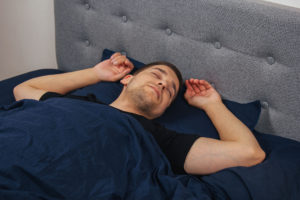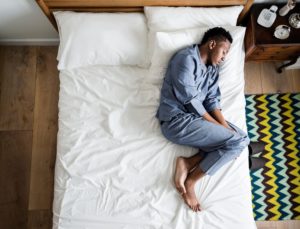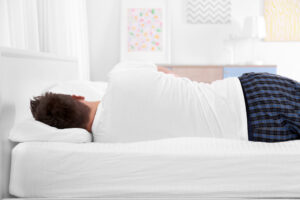When you buy through our links, we may earn a commission. Products or services may be offered by an affiliated entity. Learn more.
Side Sleeping: Which Side Is Best and How To Do It
- Side sleeping can potentially help relieve pain, reduce the risk of snoring and sleep apnea, and improve overall health.
- The best side to sleep on depends on your personal preference as well as the support of your mattress and pillow.
- Left side sleeping may benefit pregnant people or those who experience acid reflux, while right side sleeping may be preferred by people with heart conditions.
- If you experience discomfort or pain, try a different sleeping position.
Not only is side sleeping preferred by 60% of adults , but it is also considered to be one of the healthiest sleep positions. Side sleeping offers many benefits, from improved spinal alignment to a reduced risk of snoring , heartburn , and back pain.
To unlock the full potential of these benefits, however, you need to get into just the right position. Learn more about how to sleep on your side, which side you should choose, and what else to consider.
Is Your Troubled Sleep a Health Risk?
A variety of issues can cause problems sleeping. Answer three questions to understand if it’s a concern you should worry about.
Benefits of Sleeping On Your Side
Research demonstrates many benefits to sleeping on your side.
Back Pain Relief
Many people live with chronic pain, especially in their lower back. Sleeping in the wrong position, such as on your stomach, can increase the amount of pressure on your spine and lead to pain upon waking. When people switch to side sleeping, however, they report back pain relief.
Reduced Risk of Snoring and Sleep Apnea
People tend to snore more when sleeping on their backs instead of their sides. When you sleep on your back, it is easier for your tongue to fall back into your throat, creating an obstruction that can result in snoring.
When you sleep on your side, your airway may stay more open, so you can breathe easier. For this reason, physicians recommend people with position-dependant sleep apnea, a serious sleep-related breathing disorder, sleep on their side to help relieve symptoms.
Improved Gut Health
Your body position influences how well your digestive system functions, and gas does not clear your system as quickly when you lie on your back. People who experience heartburn, constipation, bloating, or other gastrointestinal issues may feel relief if they sleep on their side.
Improved Brain Health
Your brain gets rid of waste throughout the day and night, but it does the majority of this important work at night while you sleep. Researchers analyzed whether your sleep position affects your brain’s efficiency in waste removal, and the side sleeping position allows for faster waste removal than either the stomach or back sleeping positions.
Healthier Pregnancy
Side sleeping is recommended for pregnant people , because it is easier for the heart to pump blood through the body in this position. Side sleeping also prevents the baby from putting too much pressure on the vein that carries blood back from the mother’s legs to their heart. Side sleeping is considered safer during pregnancy, since back sleeping is associated with an increased risk of late stillbirth in some studies. It may also relieve pregnancy-associated back pain.

Which Side Is Best to Sleep On?
Whether you should sleep on your right or left side depends on which health issues you face. The left side may provide more benefits, particularly for those who are pregnant, or experience gastroesophageal reflux disease (GERD). People with these conditions might want to take special care to sleep on their left side. People with heart failure , however, might experience discomfort on their left sides and instead prefer to sleep on their right sides.
During Pregnancy
Sleeping on the left side is recommended for pregnant people. Sleeping on this side improves blood flow between the heart, fetus, uterus, and kidneys, while keeping pressure off the liver.
If you get uncomfortable, physicians recommend switching to the right side for a short while rather than sleeping on your back.
If You Experience Heartburn
When people with GERD sleep on their left side, they experience fewer instances of heartburn than when they sleep on the right side or on their back. Not only are heartburn episodes more frequent on the right side, but they also last longer .
Pregnant people can also experience heartburn, since pregnancy causes the digestive system to move more slowly. Sleeping on the left side can relieve their heartburn, while also making it easier for their heart to pump blood to the fetus.
Tips for Side Sleeping
When side sleeping, it may help to follow these tips to optimize this position for better sleep.
Get Into a Symmetrical Side Sleeping Position
Symmetrical side sleeping is preferable to asymmetrical side sleeping. Supporting the natural curvature of your spine, from your head to your hips, helps prevent any aches and pains in the morning.
- Lie on your side with your head on the pillow.
- Ensure your chin and neck are aligned in the center of your shoulders, and your shoulders are in line with your hips.
- Keep your head looking forward, so your chin does not tilt down to your neck or twist to the side.
- Keep your arms and hands aligned with each other, either by your sides or slightly in front of you.
- Consider placing a small pillow between your knees to relieve pressure on the hips and prevent your knees from collapsing onto each other.
Many side sleepers opt for a fetal position, with their legs bent and curled in toward their chest. This position can relieve pressure in the back. Curling up too tight in this position, however, can make it more difficult to breathe.
Pregnant people may find placing pillows under the abdomen and between the legs relieves additional pressure. Placing another firm pillow or rolled up blanket at the small of the back can help prevent additional discomfort.
Pick a Mattress That Supports Side Sleeping
If your mattress allows you to sleep well and wake up feeling refreshed, then it is a good mattress for you. People’s mattress preferences can range from extremely soft to very firm, but medium firm mattresses have been demonstrated to reduce pain in side sleepers.
Mattresses that are too soft can allow heavier parts of your body, like your hips or your shoulders, to sink too deeply into the mattress. During the night, your spine might stretch out of alignment, and you may wake up with aches and pains in the morning.
Mattresses that are too firm, on the other hand, don’t provide enough cushioning for these pressure points when you are sleeping on your side. As a result, a gap can form between your waist and the mattress surface. Your abdomen might sink in to fill this space, leading to discomfort and spinal misalignment.
Medium Firm beds tend to be the right mattress for side sleepers, because they typically balance contouring and support. They allow enough cushioning for the heavier parts of your body to sink deeper into the mattress, while being firm enough to prevent them from sinking too deeply and causing spinal misalignment.
Most mattress companies offer trial periods ranging from 30 to 100 nights. This allows you to try the mattress out, sleep on it for a few weeks, and determine if it is the right fit.
Get a Pillow Designed for Side Sleepers
The best pillow for side sleepers is one that supports proper alignment between your neck and the rest of your spine . Your neck should stay aligned with your upper back to avoid creating any pressure or neck pain upon waking up. If you sleep on your side and are prone to neck pain, you might want to avoid a feather pillow and opt for a supportive latex pillow instead.
Measure the distance between the die of your neck and the edge of your shoulder. When you go shopping for pillows, that measurement should be close to the pillow’s loft, which describes the height of a pillow.
You can use additional pillows to make side sleeping more comfortable. Place a pillow between your knees to keep your hips aligned, reduce pressure on your knee joints, and prevent straining your lower back.
When to Consider a Different Sleeping Position
If you find you cannot get comfortable sleeping on your side, you may want to switch to sleeping on your back instead. The back sleeping position offers many potential benefits, including back pain relief, especially when used in combination with side sleeping.
If you switch from side to back sleeping, a thinner pillow may help support your new sleep position. While side sleepers often sleep best with a higher loft pillow, back sleepers do better with a medium loft — a pillow that is high enough to provide cushioning for the neck, but not too high that it causes their chin to tilt forward into the chest as this may worsen breathing.
Additionally, if you are worried about wrinkles, be aware that sleeping on your side with your face pressed into the pillow can compress and stress your skin, leading to wrinkles . Sleeping on your back allows you to reduce this wrinkle-causing pressure.
Side sleeping can also lead to or exacerbate existing shoulder pain , since you are placing more pressure on the shoulder facing the mattress. To minimize your risk of shoulder pain, try alternating between sides. It may also help to focus on keeping your head and neck aligned evenly between both shoulders, and use a supportive mattress and pillow combination that does not let you sink too deeply into the mattress.
Side sleeping can help you sleep more deeply, but it is not for everyone. If you experience discomfort or pain after sleeping in this position, talk to your doctor.
References
15 Sources
-
Cary, D., Briffa, K., & McKenna, L. (2019). Identifying relationships between sleep posture and non-specific spinal symptoms in adults: A scoping review. BMJ Open, 9(6), e027633.
https://pubmed.ncbi.nlm.nih.gov/31256029/ -
Desouzart, G., Matos, R., Melo, F., & Filgueiras, E. (2015). Effects of sleeping position on back pain in physically active seniors: A controlled pilot study. Work, 53(2), 235–240.
https://pubmed.ncbi.nlm.nih.gov/26835867/ -
Ravesloot, M. J., van Maanen, J. P., Dun, L., & de Vries, N. (2013). The undervalued potential of positional therapy in position-dependent snoring and obstructive sleep apnea: A review of the literature. Sleep & breathing, 17(1), 39–49.
https://pubmed.ncbi.nlm.nih.gov/22441662/ -
Khoury, R. M., Camacho-Lobato, L., Katz, P. O., Mohiuddin, M. A., & Castell, D. O. (1999). Influence of spontaneous sleep positions on nighttime recumbent reflux in patients with gastroesophageal reflux disease. The American journal of gastroenterology, 94(8), 2069–2073.
https://pubmed.ncbi.nlm.nih.gov/10445529/ -
Dainese, R., Serra, J., Azpiroz, F., & Malagelada, J. R. (2003). Influence of body posture on intestinal transit of gas. Gut, 52(7), 971–974.
https://pubmed.ncbi.nlm.nih.gov/12801953/ -
Lee, H., Xie, L., Yu, M., Kang, H., Feng, T., Deane, R., Logan, J., Nedergaard, M., & Benveniste, H. (2015). The effect of body posture on brain glymphatic transport. The Journal of Neuroscience: The Official Journal of the Society for Neuroscience, 35(31), 11034–11044.
https://pubmed.ncbi.nlm.nih.gov/26245965/ -
A.D.A.M. Medical Encyclopedia. (2020, June 2). Problems sleeping during pregnancy. MedlinePlus., Retrieved July 15, 2021, from
https://medlineplus.gov/ency/patientinstructions/000559.htm -
Bayraktar, M. F., & Ozeke, O. (2018). Serial echocardiographic changes with different body positions and sleeping side preference in heart failure patients. Echocardiography, 35(8), 1132–1137.
https://pubmed.ncbi.nlm.nih.gov/29648700/ -
Katz, L. C., Just, R., & Castell, D. O. (1994). Body position affects recumbent postprandial reflux. Journal of Clinical Gastroenterology, 18(4), 280–283.
https://pubmed.ncbi.nlm.nih.gov/8071510/ -
Jacobson, B. H., Boolani, A., Dunklee, G., Shepardson, A., & Acharya, H. (2010). Effect of prescribed sleep surfaces on back pain and sleep quality in patients diagnosed with low back and shoulder pain. Applied Ergonomics, 42(1), 91–97.
https://pubmed.ncbi.nlm.nih.gov/20579971/ -
Gordon, S. J., Grimmer-Somers, K. A., & Trott, P. H. (2011). A randomized, comparative trial: Does pillow type alter cervico-thoracic spinal posture when side lying? Journal of Multidisciplinary Healthcare, 4, 321–327.
https://pubmed.ncbi.nlm.nih.gov/21966226/ -
Gordon, S. J., Grimmer-Somers, K., & Trott, P. (2009). Pillow use: The behavior of cervical pain, sleep quality and pillow comfort in side sleepers. Manual Therapy, 14(6), 671–678.
https://pubmed.ncbi.nlm.nih.gov/19427257/ -
Gordon, S. J., Grimmer-Somers, K. A., & Trott, P. H. (2010). Pillow use: The behavior of cervical stiffness, headache and scapular/arm pain. Journal of Pain Research, 3, 137–145.
https://pubmed.ncbi.nlm.nih.gov/21197317/ -
Anson, G., Kane, M. A. C., & Lambros, V. (2016). Sleep wrinkles: Facial aging and facial distortion during sleep. Aesthetic Surgery Journal, 36(8), 931–940.
https://pubmed.ncbi.nlm.nih.gov/27329660/ -
Zenian, J. (2010). Sleep position and shoulder pain. Medical Hypotheses, 74(4), 639–643.
https://pubmed.ncbi.nlm.nih.gov/20036076/
















